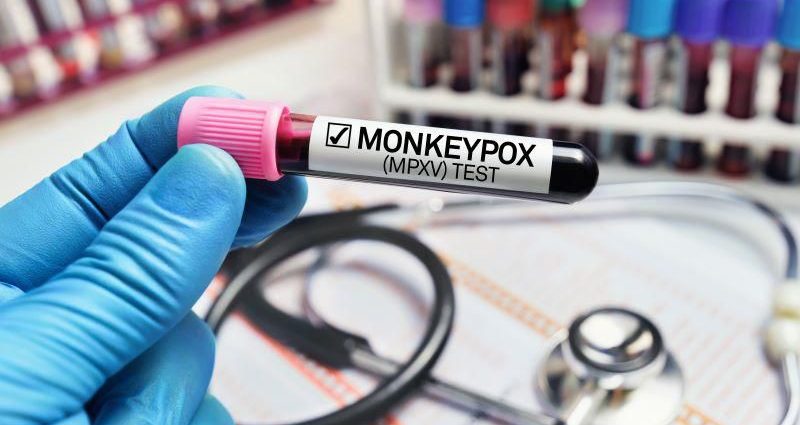THURSDAY, Nov. 3, 2022 (HealthDay News) — Monkeypox spreads even before a person shows any telltale lesions or other symptoms, a new study suggests.
More than half of monkeypox transmission in the United Kingdom occurred in the pre-symptomatic phase, the researchers said.
The new findings — published online Nov. 2 in the BMJ — may explain why monkeypox spread so quickly. More than 70,000 cases have been identified worldwide since an international outbreak started in May, but cases do seem to be on the decline.
Monkeypox is a cousin of the smallpox virus, and the smallpox vaccine can protect people from monkeypox.
Monkeypox transmission was seen up to four days before symptoms started, and the researchers estimated that 53% of transmission occurred during this phase. Thomas Ward, head of infectious disease modeling at the UK Health Security Agency in London, led the new study.
In the past, it was thought that monkeypox only spreads when a person is showing symptoms, said Hannah Newman, director of infection prevention at Lenox Hill Hospital in New York City. She has no ties to the research.
Currently, the U.S. Centers for Disease Control and Prevention states that people can transmit the infection only after they develop symptoms.
“Prior to this study, researchers were aware it was possible to shed the virus before symptoms appeared, however, it was unknown how common that may occur,” Newman said. “These findings could also have important implications for global infection control and raise questions on whether the current guidance — asking people to isolate once symptomatic — is enough to prevent transmission of the virus.”
For the study, the researchers tapped into routine surveillance and contact tracing data for more than 2,700 individuals in the United Kingdom who tested positive for the monkeypox virus between May 6 and Aug. 1, 2022.
The investigators looked at the time symptoms started in the first patient to symptom onset in the next contact, and at the time from exposure to onset of symptoms. They created two models.
The average incubation period was estimated to be 7.6 days in one model and 7.8 days in the other. The estimated serial interval — time between the start of symptoms in one person and in the person they infected — was 8 days in one model and 9.5 days in the other.
Fully 10 of 13 patient pairs reported pre-symptomatic transmission. Four days was the maximum time that transmission was detected before monkeypox symptoms appeared, the study showed.
Several experts stressed the importance of both prudence and prevention during the ongoing outbreak.
Don’t assume your partner is not infectious just because they aren’t exhibiting symptoms, Newman said. “People should be aware of this and adjust behavior based on risk tolerance,” she advised.
If someone is in a high-risk group, the first thing they can do is get vaccinated if they haven’t already, she said. Gay, bisexual, and other men who have sex with men make up the majority of cases in the current monkeypox outbreak.
“Have open communication with sexual partners and anyone you will have close contact with [and] avoid close skin-to-skin contact (sexual intercourse, kissing, or touching each other’s bodies, or sharing towels, toothbrushes, etc.) with anyone who has been diagnosed with monkeypox and anyone who thinks they were exposed to someone with monkeypox, even if they are not showing symptoms,” Newman said.
People with active monkeypox and those who are caring for them or close to them should wear masks and avoid direct skin-to-skin contact, and take care in handling contaminated items like clothing or linens, Newman added.
Dr. Esther Freeman, director of the Center for Global Health at Massachusetts General Hospital and an associate professor of dermatology at Harvard Medical School in Boston, co-wrote an editorial that accompanied the new study.
Freeman noted that pre-symptomatic means that there will be symptoms, ultimately. By contrast, asymptomatic means there won’t be symptoms. “There may be subtle symptoms that haven’t been noticed yet or no symptoms among pre-symptomatic people with monkeypox,” she said.
The good news is that doctors know how to prevent monkeypox.
“Vaccines are really important, and we are very lucky we already have a really safe vaccine that is working well,” Freeman said. “We also need to increase access to vaccines, especially outside of the U.S.”
It’s a two-dose vaccine regimen, but even one shot helps, she added.
Dr. Timothy Brewer, a professor of medicine and epidemiology at the University of California, Los Angeles, was not involved with the study but reviewed the findings. He said there is more pre-symptomatic transmission of monkeypox happening than people appreciated.
This makes contact tracing an uphill battle, he noted.
“Monkeypox is not spreading as easily as COVID-19 or other respiratory viruses,” Brewer said. “It’s not as easy to transmit monkeypox as it really requires physical contact with secretions and body fluid.”
So, what else can you do to stay safe?
“If you have any recent sexual contacts and new rash, get in contact with your doctor to see if you have monkeypox, and if you have sex with new partners, use barrier protection such as condoms, and don’t have sex if you see lesions,” Brewer advised.
More information
The American Academy of Dermatology has more on monkeypox.
SOURCES: Hannah Newman, MPH, director, infection prevention, Lenox Hill Hospital, New York City; Esther Freeman, MD, PhD, director, Center for Global Health Dermatology, Massachusetts General Hospital, and associate professor, dermatology, Harvard Medical School, Boston; Timothy Brewer, MD, MPH, professor, medicine and epidemiology, University of California, Los Angeles; BMJ, Nov. 2, 2022, online
Copyright © 2025 HealthDay. All rights reserved.

